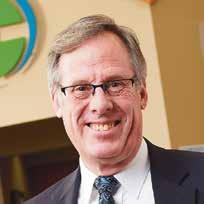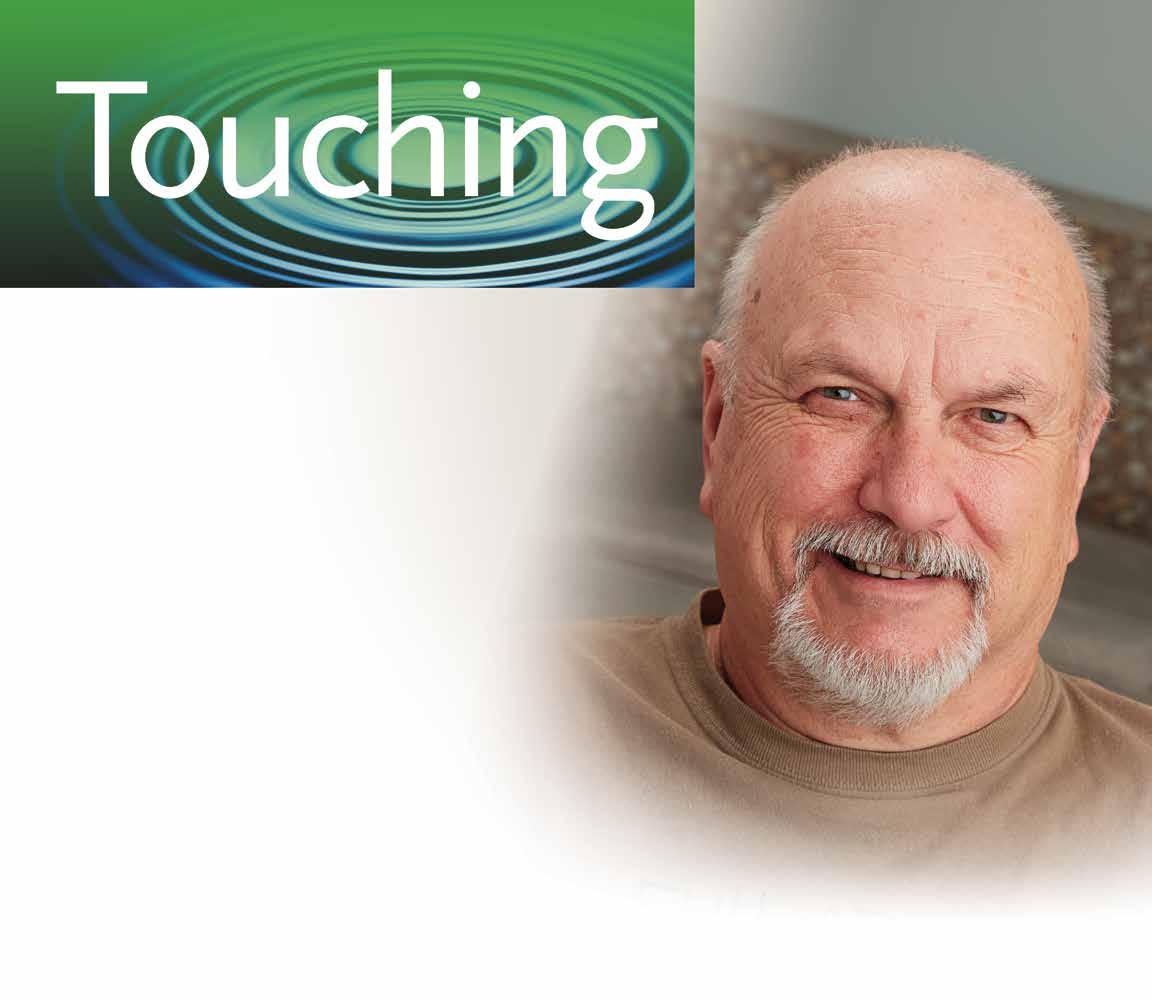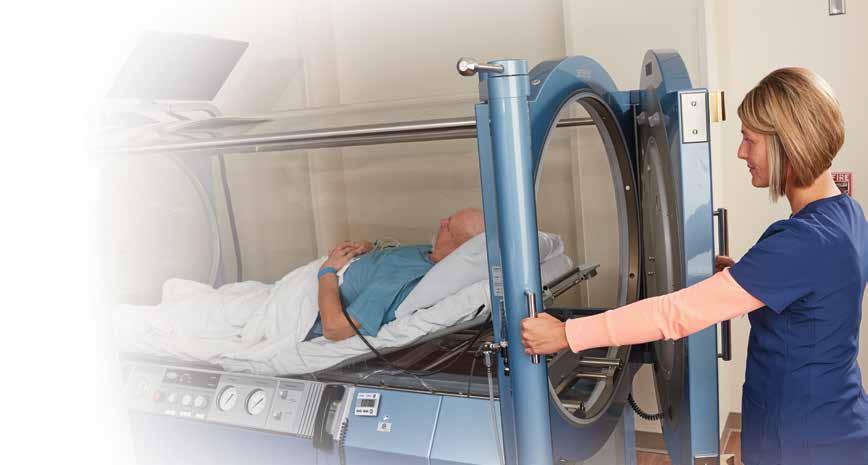
5 minute read
Hyperbaric oxygen therapy healed him Neuropathy hurt Bill’s feeling
Bill Korpela remembers the day – years ago – when a coworker pointed out he’d been walking around with a board stuck to the bottom of his shoe. It was a surprise and an omen of health struggles to come. The reason Bill didn’t feel the nail turned out to be diabetic neuropathy. It’s a condition in which high blood sugar levels cause nerve damage in the legs and feet. Symptoms range from shooting, burning pain to a total loss of feeling.
Bill was diagnosed with type 2 diabetes when he was 44. Now 66 and retired, he has lost almost all sensation in both of his legs below the mid-calf.
“We can’t predict who will develop neuropathy, but we do know it’s more likely when a patient’s blood sugar levels run higher over time,” says Bill’s family medicine physician, Bryan Petersen, MD.

“Bill’s diabetes has been more difficult for him to control, with wide swings in his blood sugar. This puts him at greater risk to develop complications like neuropathy.”
Complications from lack of feeling
People with diabetic neuropathy often can’t feel injuries to their legs and feet, which could be as simple as a callus from an illfitting shoe. Minor wounds can develop life- and limb-threatening infections quickly, sometimes in a matter of hours if the patient’s diabetes is not well controlled. People with neuropathy also tend to heal slowly due to poor circulation, nutritional factors and walking with a sore on the
Bill also has a complication of diabetes called peripheral vascular disease (PVD). In this condition, elevated blood sugars damage the blood vessels, causing them to narrow and reduce the flow of oxygenated blood to the feet.

“Any open wound on the foot heals more slowly when blood flow is inadequate,” says Amie Scantlin, DPM, MS, FACFAS, a GRHS podiatrist who has cared for Bill for about eight years and also treats patients at the GRHS Center for Advanced
When wounds don’t heal properly, tissue can break down and die, which can lead to amputation. Just ask Bill. “It took five days for one toe to develop gangrene, and two days later it was amputated,” he says. That’s why people with diabetes should have a physician check their feet at least once a year and check their own feet daily, using a mirror to see the bottoms. Dr. Scantlin advises those with neuropathy and/or PVD to see a clinician for a foot check every three months. Foot sores require an immediate visit.
We were so busy with construction and new service introductions during 2016 that we failed to mention (or celebrate) the 75th anniversary of Glencoe Regional Health Services. I’d like to pause and do so now.
Construction on Glencoe Municipal Hospital began in 1941. It was funded with a grant from the Works Projects Administration (WPA), municipal bonds and individual donations. You can still see the façade of the original hospital building if you travel past our campus along 18th Street East. When you do, I hope you’ll reflect on the ways that our independent, community-based health care system enriches life in Glencoe. For example, we are governed by a board of local citizens that keeps community interests at the forefront of our decision-making. We are the largest employer in town with more than 500 workers. We train doctors and other health care professionals, and grant scholarships so area students can prepare for careers in health care. As a non-profit, we commit our resources to meeting the health needs of people in Glencoe and surrounding communities.
On that point, I also want to let you know that we recently published a report on our 2016 community health needs assessment. It summarizes a process that takes place every three years to identify any gaps between our activities and the needs of the community. Please visit grhsonline.org/chna to read our 2016 report and submit your comments for consideration during our next assessment process in 2019.
Your Input
Join our advisory council
The GRHS Patient and Family Advisory Council provides insight that helps us improve our care and services. We are currently seeking new council members. If you’d like to volunteer in this capacity, visit grhsonline.org/advisory-council for details and an application.
My Chart
Get connected with MyChart
Ask the receptionist or nurse to help you sign up at your next GRHS clinic appointment or hospital visit. You also may visit grhsonline.org/mychart to download a sign-up form.
For assistance, call MyChart Services toll free at 1-855-551-6555 from 8 am to 8 pm, Monday through Friday.
Health Talks
Tumbles, Stumbles and Spills
Chad Robbins, DO, FACOS
Clark Christianson, PT, ScD, COMT
Tuesday, February 28
6:30 - 7:30 pm
GRHS conference rooms, Glencoe
Please use the clinic entrance
Cardiovascular Disease
Sheryl Bartholow, FNP-BC
Monday, April 3
7 - 8 pm
Stewart Community Center
551 Prior Street, Stewart
There is no charge to attend but we ask that you reserve a seat online at grhsonline.org/health-talks or by calling
320-864-7146 or 1-888-526-4242, ext. 7146.
Health News
Listen to Health Update
Sponsored by GRHS
Airing on KDUZ-AM 1260
Second Tuesday of the month 2:35 pm
Follow us on social media
Touching
Publisher: Glencoe Regional Health Services 1805 Hennepin Avenue North Glencoe, MN 55336
Managing Editor: Nancy Ellefson
Editorial Advisory Board:
Ana Alexander
Jon Braband
John Doidge
Jill Hatlestad
Patty Henderson
Kristine Knudten, MD
Laura Kuvaas
Julie Schmidt continued from page 1
Your ideas and opinions are important to us. Contact Nancy Ellefson at 320-864-7798 or nancy.ellefson@grhsonline.org with suggestions or comments.
Healing powers of pure oxygen
Bill has had multiple surgeries on his right foot due to the effects of neuropathy and PVD. The most recent, on Aug. 17 in the Twin Cities, removed half of his foot. His surgeon recommended that Bill’s recuperation include an extended stay in post-acute transitional care, paired with hyperbaric oxygen therapy. Because Bill had seen Drs. Petersen and Scantlin for years, he knew GRHS was among the very few regional hospitals to offer both services.
“I was thrilled to get oxygen therapy in Glencoe,” Bill says. “I could see my doctors and it was much more convenient than going to the Twin Cities every day.”
Therapy is usually scheduled five days a week for several weeks. Patients spend two hours per session in a hyperbaric oxygen chamber. While 100-percent oxygen circulates, patients can sleep, watch television or a movie, or listen to music.

“Breathing pure oxygen in a pressurized environment helps it reach every part of the body, including wounds in limbs with poor circulation,” says Dr. Scantlin.
Just days into Bill’s first round of hyperbaric oxygen therapy, a small sore on his left foot had completely healed. After seven more weeks of treatment,
With
LPN, his right foot appeared healed. But when Dr. Scantlin removed heavy scabs, the wound underneath remained open so Bill started a second round of therapy.
“If Bill’s foot wound had not healed, he probably would have lost his leg,” says Dr. Scantlin. “That second round of hyperbaric oxygen therapy saved his leg.”
Making strides
With the healing process nearly complete, Bill started physical therapy in early
December to learn how to walk “heel first” on the remaining portions of his right foot. Guided by therapists but boosted by hard work, a positive attitude and a custommolded shoe, Bill is now walking with a cane.
He is grateful for his caregivers and the technology that sparked his healing. “We take so much for granted,” Bill says, “A lot can happen if you don’t take care of yourself. When it does, it wakes you up. Life is precious.”



